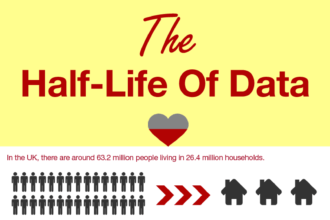Top 8 Big Data Trends in 2014 That Marketers Should Care About
Biggest hurdles, pre-targeting, personalization, new jobs and more
Being an effective marketer was exponentially harder 2014 with the advent of big data and related tools and functionality. Buzzwords like predictive analytics, pre-targeting and iBeacons just made marketers’ roles more complex, but also more powerful, proactive and measurable.
Top 8 Big Data Trends in 2014 That Marketers Should Care About
Biggest hurdles, pre-targeting, personalization, new jobs and more
Being an effective marketer was exponentially harder 2014 with the advent of big data and related tools and functionality. Buzzwords like predictive analytics, pre-targeting and iBeacons just made marketers’ roles more complex, but also more powerful, proactive and measurable. One thing became crystal clear, data-driven marketing is here to stay and companies worldwide will continue to increase their spend on big data technology, software and tools in the years to come. In 2009 there were very few big data projects and total industry revenue was under $100 million. A recent Oracle study projects that big data will be a $50 billion business by 2017.
As big data and advanced analytics become more mainstream, it’s vital for marketers to keep up with the trends that really matter, the solutions that push for data democratization and the easy-to-use tools that empower anyone within an organization to create, run and optimize real-world campaigns that drive engagement, loyalty and ROI.
Here are the most important big data trends in 2014 that you should care about as a marketer:
1. Most Important Business Objectives for Marketing Analytics in 2014
- Gaining Actionable Insights: This was possibly the most important business objective for all marketers in 2014. It’s not enough to just have “big data,” it’s more important to have the “right data” and know what to do with it. Marketers want easy-to-use tools that democratize data and help anyone within their team gain actionable insights from the data to drive campaigns that convert faster and better.
- Gaining better visibility into the sales funnel: These insights are valuable to marketers to help them optimize their campaigns in real-time at every touchpoint. They also want the ability to measure how marketing drives sales, renewals, sponsorships, and strategic partnerships. Having the data to clearly demonstrate the leads and ROI that marketing drives is essential.
- Measuring marketing attribution across channels: Marketers want to better understand which platforms deliver the highest ROI at the lowest CPA. Plus marketers seek the ability to run intelligent ads that can be continually optimized with real-time data.
- Gaining approval and support from top executives: Most executives know that the right customer data can help boost the bottom line, and yet gathering consensus on implementing a big data platform is still a challenge for many marketers. (Read our CEO’s Forbes article on motivating your team to start researching and actually make a decision on a big data solution ASAP.)
- A deeper understanding of who their fans and customers really are and what they love: And we’re not just talking about the fans that like you on Facebook. But also the ones that bought tickets, watched a video online, walked into a retail store, attended a conference, bought a book online etc. Marketers need to know which content converts the best at the various stages of the purchasing funnel, and what messaging resonates the most with their audience.

2. Biggest Hurdles to Data-Driven Marketing in 2014
- Lack of system integration and unified data accessible in one place
- Lack of accurate and high-quality data
- Lack of the right tools and platforms
- Lack of the tools and training needed to make sense of big data
- Budget constraints
- Inability to generate useful and actionable insights from customer data

3. Bigger Data & Analytics Budgets
Marketing and analytics budgets have grown significantly in 2014 and are expected to continue to grow across industries in 2015. Big data is a top business priority in most medium and large companies and is expected to help identify new opportunities and improve profitability. Bad or “dirty” data across businesses and the government will cost the U.S. economy $600 billion dollars a year, and companies are realizing the opportunity cost of not collecting, owning and analyzing their data.
4. Big Data Equals Big Jobs & New Educational Programs
A 2011 McKinsey report estimated that by 2018, about 140,000 to 190,000 big data jobs will be unfilled due to a lack of applicants with expertise and experience. But many schools have been slow to realize the potential of this big data talent gap and have only just started to reinvent their curriculum to equip students with the requisite skills to snag these new big data jobs. A handful of schools and organizations are starting to change that by introducing new and timely degree and certification courses in data science, analytics, marketing and data mining.
5. Big Data is Driving Personalization
Another McKinsey study found that companies who put data-driven personalization at the center of marketing and sales decisions improve marketing ROI by 10 percent or more. Marketers’ love for personalization has only been compounded by recent success stories and studies that support the power of personalization. A 2013 study from Experian Marketing Services found that emails with personalized subject lines and other personalization enjoyed a 26 percent higher open rates than those without it. In a 2014 Infosys survey, 86 percent of respondents said that personalization influenced what they purchase to some extent, and 25 percent of them said that personalization significantly influences what they purchase. While many marketers still struggle with personalization, big data is helping change this via easy-to-use analytics platforms and tools like Umbel provides.
6. You Don’t Need to Spend Millions on a Data Warehouse
Businesses large and small are taking steps to extract the maximum value from their customer data. As platforms like Umbel democratize data and make it accessible to multiple teams including marketing and sales, these teams are starting to realize the need for a data warehouse solution. Harnessing big data is clearly a critical component of staying competitive in today’s increasingly-digital landscape, and there’s no reason why non-technical professionals shouldn’t have direct access and the tools needed to leverage data to achieve their business goals. With comprehensive data solutions like Umbel, companies can now extract more value from customer data at a fraction of the cost of actually building a typical data warehouse.
7. Mobile & Beacons will be the Priority
In 2015 almost every website that wants to generate business and stay relevant will need to be mobile-friendly and super-responsive on any device. A recent study estimates that in 2015 about 3.6 billion people will be able to access broadband services (half the world’s population), and more than 1 billion people will use mobile as their only form of Internet access. Companies will need to spend the money, resources and time to ensure that the mobile experience is simple, seamless, easy-to-use and memorable. Mobile payments will become the rule, and smartphones will continue to get more sophisticated and powerful.
Plus, beacon technology, sensors, wearables and the IoT will change how people live, shop, share and stay connected. Adoption of these sensors and devices in home, vehicles, workplaces and everywhere else will go up dramatically. This year, a survey by Accenture predicted that adoption of wearable IoT technology such as smart watches and fitness devices will continue to increase, with nearly half of the consumers surveyed already owning or planning to purchase in this category in the next five years.
8. Pretargeting is the New Retargeting
Pretargeted ads use big data to predict a customer’s preferences and present them with customized messages while they’re still in the buying phase. The power of pretargeting is that it allows you to target customers based on what they’re about to do and not what they’ve just done.
Consumers continue to be a part of a digital ecosystem, connecting with social networks, checking in at places on their phones, accessing deals via iBeacons and sharing data across multiple devices. With big data, companies can now accurately track who their customers are, where they shop, what they buy, why they buy those items and what they care about. More importantly, big data is helping marketers surface the right content, at the right time, in the right place, with the right message based on predictions about the customer’s needs at that moment. Predictive advertising is here to stay and will only continue to gain popularity as people share more personal information online in return for better offers and customer experiences.
In 2015 we’ll continue to see these trends develop and mature as big data tools and usage penetrates multiple teams and companies around the world. Whether or not a company adopts data-driven strategies will define the company’s future and its ability to compete and stay relevant. Data will need to be democratized across departments and integrated into every aspect of running a company: marketing decisions, new product pipelines, sales strategy, manufacturing, recruiting and much more. Big data and advanced analytics are the future of marketing and will supercharge sales via customized and effective marketing. Are you prepared?







